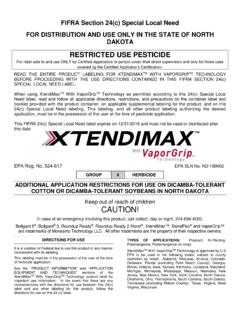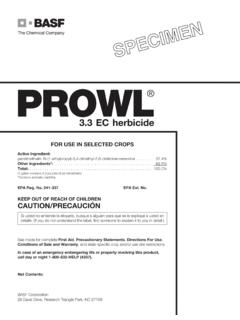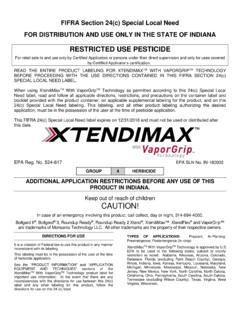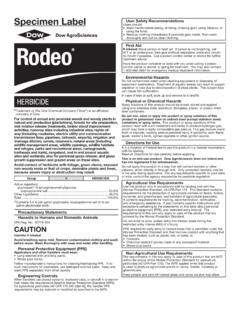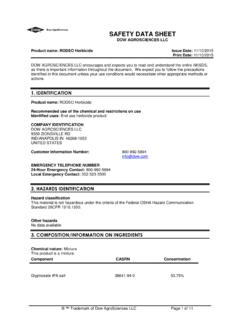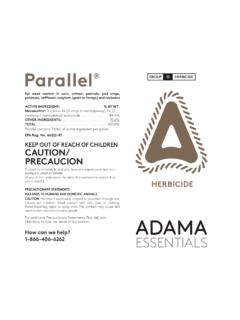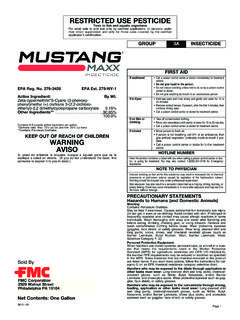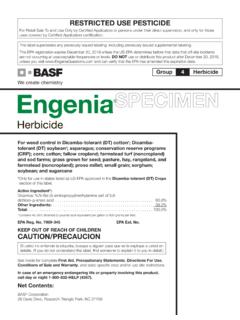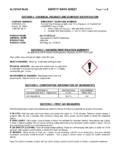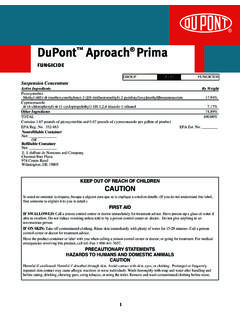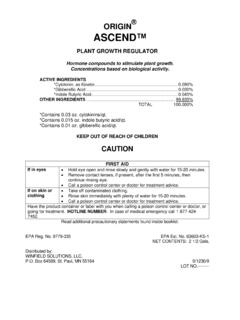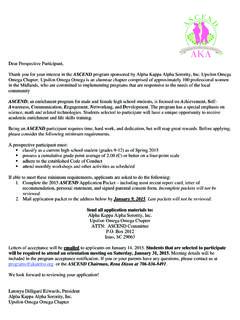Transcription of PLANT GROWTH REGULATOR - CDMS Home
1 ascend PLANT GROWTH REGULATOR Hormone compounds to stimulate PLANT GROWTH . Concentrations based on biological activity. ACTIVE INGREDIENTS *Cytokinin, as Kinetin .. *Gibberellic Acid .. *Indole Butyric Acid .. OTHER INGREDIENTS .. TOTAL *Contains oz. cytokinins/qt. *Contains oz. indole butyric acid/qt. *Contains oz. gibberellic acid/qt. KEEP OUT OF REACH OF CHILDREN CAUTION FIRST AID If in eyes Hold eye open and rinse slowly and gently with water for 15-20 minutes. Remove contact lenses, if present, after the first 5 minutes, then continue rinsing eye. Call a poison control center or doctor for treatment advice. If on skin or clothing Take off contaminated clothing. Rinse skin immediately with plenty of water for 15-20 minutes.
2 Call a poison control center or doctor for treatment advice. Have the product container or label with you when calling a poison control center or doctor, or going for treatment. HOTLINE NUMBER: In case of medical emergency call 1-877-424-7452. Read additional precautionary statements found inside booklet. SHAKE WELL BEFORE USING. EPA Reg. No. 9779-335 EPA Est. No. 63603-KS-1 NET CONTENTS: 1 Gal. Distributed by: WINFIELD SOLUTIONS, LLC, Box 64589, St. Paul, MN 55164 1/0805/3 Lot 2 PRECAUTIONARY STATEMENTS HAZARDS TO HUMANS AND DOMESTIC ANIMALS Caution: Causes eye irritation. Harmful if absorbed through skin.
3 Avoid contact with skin, eyes, or clothing. Wash thoroughly with soap and water after handling. Remove and wash contaminated clothing before reuse. Wear the appropriate Personal Protective Equipment (PPE). Personal Protective Equipment: Mixers, loaders, applicators and other handlers must wear: long-sleeved shirt and long pants, shoes plus socks, and chemical-resistant gloves. Follow manufacturer's instructions for cleaning and maintaining PPE. If no instructions for washables, use detergent and hot water. Keep and wash PPE separately from other laundry. USER SAFETY RECOMMENDATIONS Users should: Wash hands before eating, drinking, chewing gum, using tobacco or using the toilet. Remove clothing immediately if pesticide gets inside.
4 Then wash thoroughly and put on clean clothing. Remove PPE immediately after handling this product. Wash the outside of gloves before removing. As soon as possible, wash thoroughly and change into clean clothing. ENVIRONMENTAL HAZARDS For terrestrial uses: Do not apply directly to water, or to areas where surface water is present or to intertidal areas below the mean high water mark. Do not contaminate water by cleaning of equipment or disposal of equipment washwater or rinsate. DIRECTIONS FOR USE It is a violation of Federal law to use this product in a manner inconsistent with its labeling. Do not apply this product in a way that will contact workers or other persons, either directly or through drift.
5 Only protected handlers may be in the area during application. For any requirements specific to your State or Tribe, consult the State or Tribal agency responsible for pesticide regulation. AGRICULTURAL USE REQUIREMENTS Use this product only in accordance with its labeling and with the Worker Protection Standard, 40 CFR part 170. This standard contains requirements for the protection of workers on farms, forests, nurseries, and greenhouses, and handlers of agricultural pesticides. It contains requirements for training, decontamination, notification, and emergency assistance. It also contains specific instructions and exceptions pertaining to the statements on this label about personal protective equipment and restricted-entry intervals.
6 The requirements in this box only apply to uses of this product that are covered by the Worker Protection Standard. Do not enter or allow worker entry into treated areas during the restricted-entry interval (REI) of 4 hours unless wearing appropriate PPE. EXCEPTION: If the product is soil-incorporated, the Worker Protection Standard, under certain circumstances, allows workers to enter the treated area if there will be no contact with anything that has been treated. 3 PPE required for early entry to treated areas that is permitted under the Worker Protection Standard and that involves contact with anything that has been treated such as plants , soil, or water, is: coveralls over long-sleeved shirt and long pants, chemical-resistant gloves, and shoes plus socks.
7 GENERAL CHEMIGATION INSTRUCTIONS Apply this product only through sprinkler including center pivot, lateral move, side (wheel) roll, traveler, big gun, solid set, hand move, or furrow irrigation systems. Do not apply this product through any other type of irrigation system. Crop injury, lack of effectiveness, or illegal pesticide residues in the crop can result from non-uniform distribution of treated water. If you have questions about calibration, you should contact State Extension Service specialists, equipment manufacturers or other experts. Do not connect an irrigation system (including greenhouse systems) used for pesticide application to a public water system unless the pesticide label prescribed safety devices for public water systems are in place.
8 A person knowledgeable of the chemigation system and responsible for its operation, or under supervision of the responsible person, shall shut the system down and make necessary adjustments should the need arise. Maintain agitation in the supply tank while adding the required amount of ascend , and throughout the application. ascend should be added to the supply tank at the end of water application (prior to last complete cycle in moving systems). The correct amount of ascend to add is calculated as the rate in fluid oz. per acre x the number of acres covered by the contents of the supply tank. (For example, if the supply tank covers ten acres and the rate on the label for that crop is 2 fluid ounce per acre, add 10 x 2 = 20 fluid ounces to the supply tank at the beginning of the last full cycle).
9 CHEMIGATION SYSTEMS CONNECTED TO PUBLIC WATER SYSTEMS Public water system means a system for the provision to the public of piped water for human consumption if such system has at least 15 service connections or regularly serves an average of at least 25 individuals daily at least 60 days out of the year. Chemigation systems connected to public water systems must contain a functional, reduced-pressure zone, backflow preventer (RPZ) or the functional equivalent in the water supply line upstream from the point of pesticide introduction. As an option to the RPZ, the water from the public water system should be discharged into a reservoir tank prior to pesticide introduction. There shall be a complete physical break (air gap) between the outlet end of the fill pipe and the top or overflow rim of the reservoir tank of at least twice the inside diameter of the fill pipe.
10 The pesticide injection pipeline must contain a functional, automatic, quick-closing check valve to prevent the flow of fluid back toward the injection pump. The pesticide injection pipeline must contain a functional, normally closed, solenoid-operated valve located on the intake side of the injection pump and connected to the system interlock to prevent 4 fluid from being withdrawn from the supply tank when the irrigation system is either automatically or manually shut down. The system must contain functional interlocking controls to automatically shut off the pesticide injection pump when the pump motor stops, or in cases where there is no water pump, when the water pressure decreases to the point where pesticide distribution is adversely affected.
